Interview with HSU
General-Major of aviation
Mikhail Ivanovich Mikhin
by Oleg Korytov and
Konstantin Chirkin
Editor: Igor Zhidov
Comments by Igor Seidov
Translation by Oleg Korytov
Special thanks to Svetlana Spiridonova
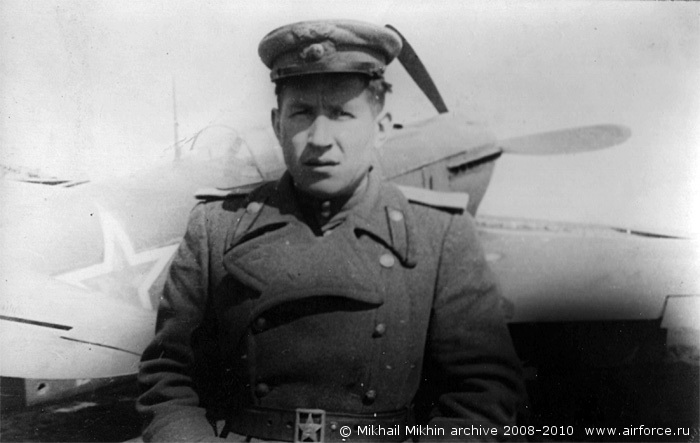
Mikhin by the side of his Yak-9u
Mikhail Ivanovich Mikhin: I was born in
1923, 25 October. My parents were peasants. Father had four classes of
church school. There was no possibility to get better education then, and
four classes were like complete technical education nowadays.
— How did you make it to aviation?
By free will. It was in Alma-Ata. In 9th
grade I joined aero club. Flew U-2. When I graduated from aero club, it
happened a month or two after War broke out; our group was sent to Orenburg
flight school. It trained bomber pilots, while I wanted to become a fighter
pilot, so I did not finish it.
— How your future pilots’ profession
was chosen? Was it a question of luck?
Not luck. At first I trained to become a
bomber pilot, then, by my own initiative I wrote a rapport to be transferred
to fighter school. I graduated from Kachinskoye flight school, which was
evacuated to Kazakhstan from Crimea.
— That is, you could write a rapport…
There was such possibility…
— How training was organized?
At first theory… It lasted too long. After
it we began flying first U-2, then UT-2.
— There are a lot of accounts that UT-2
was prone to flat spins.
There were cases. But it mostly it was a
UT-1 problem. UT-1 was much more prone to spins. But I never flew it, so I
can’t say more. UT-2 was more or less stable airplane.
— Which plane you flew after UT-2?
Yak-7b. I graduated from school on Yaks
and kept flying them in combat units until we began training on jets.
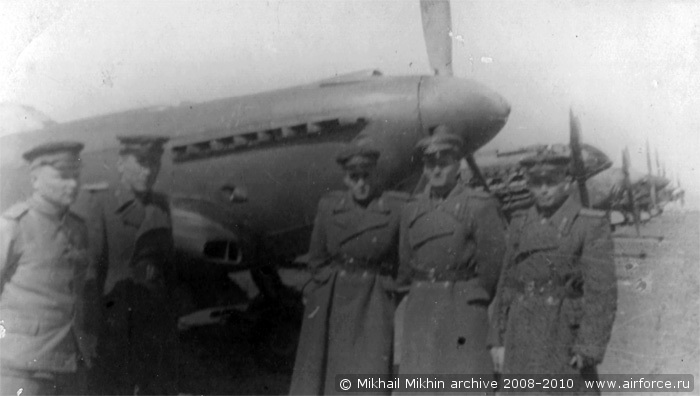
518 IAP at the regiment airplane row.
— When you graduated?
In 1944, November or December. It took
some time for organization questions and so on… I arrived to combat unit in
January 1945.
— Where exactly?
To Kharkov, airfield was near town. To be
precise – to Rogan training regiment. When war with Germany ended, division
was rebased to Russia. From that moment till demobilization I served in
518th IAP.
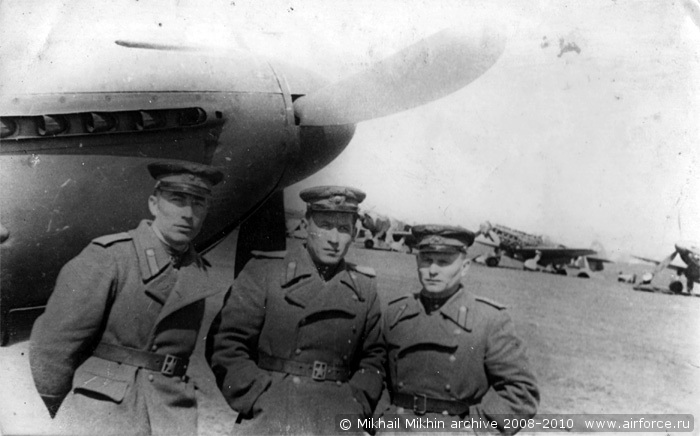
At the regiments airplane row -, Mikhin, -
— Did you see action during GPW?
No. I was in training regiment, taught
pilots how to fight, even though I haven’t fought myself. To be exact – I
taught them of combat use.

Alexei Lavrov by the side of his Yak
— How you got to Korea?
How? Volunteered by order. We were sent…
As it was called «Motherland sent». Whole division was sent there.
— And when you arrived there?
In 1952. Stayed till the end.
— At which position you were there?
At first flight commander, then deputy
squadron commander, then squadron commander. Finished as deputy regiment
commander.
— Which airplane types you had in
Korea?
MiG-15. At first there were Las, Yak-17s,
but they were quickly withdrawn.
— Porfiriy Ovsyannikov told us how they
used Yak-17s to train Chinese pilots to fly. They had no UTI MiG-15s.
On Yak-17s? We had dual control MiGs…
— Where you were based?
In Myaogou, in Anshan... Mostly in
Myaogou. Then for a short period of time on another airfield nearby...
Forgot how it’s called… (Most likely he speaks of another forward airfield
Dapu, where another regiment of 216th IAD was based. I.S.)
— What kinds of orders you received?
What kind of orders we could receive at
war? To fight. Mostly - intercept. We also patrolled and defended Suphum
hydroelectric plant at Yaludzyan River… And bridges over Yaludzyan. We
arrived when one of the bridges was destroyed, and only one remained.
— Did they destroy Suphum HEP?
No. They tried, but couldn’t. It was huge.
There were no munitions to destroy it.
— With which planes you fought?
With American planes, who else… Main
airplane types were Sabers. At first there were Thunderjets, but they were
wiped out pretty soon, and only Sabers remained.
— Were there B-29s?
At first they were flying, but only at
night, and soon disappeared.
— Did you see them at day time?
No, not at day time. It would have been
suicide for them.
— How many flying hours you had on
MiG-15 when you arrived to Korea?
Not too many. God knows haw many. Not more
than 100 hours.
— Did you have combat use training on
MiGs?
Only training fights and shooting practice
at cones and ground targets.
— When you came to Korea, were you told
about American planes or their tactics?
Who could have told us all that?
— What about those whom you were
changing?
We-e-ell, they disappeared very fast...
— So, all the "perils of war" you had
to try out on your own skin?
Yes.
— How war began for you? From victory?
From defeat?
For me? It wasn’t even first combat
mission, just area familiarization flight. We looked at the area of our
responsibility. My wingman was shot down. (It happened on 5th August
1952. In this flight Mikhins wingman Senior Lieutenant Ivan Yakovlev was
shot down by surprise attack. He managed to safely eject and later joined
his comrades. I.S.).
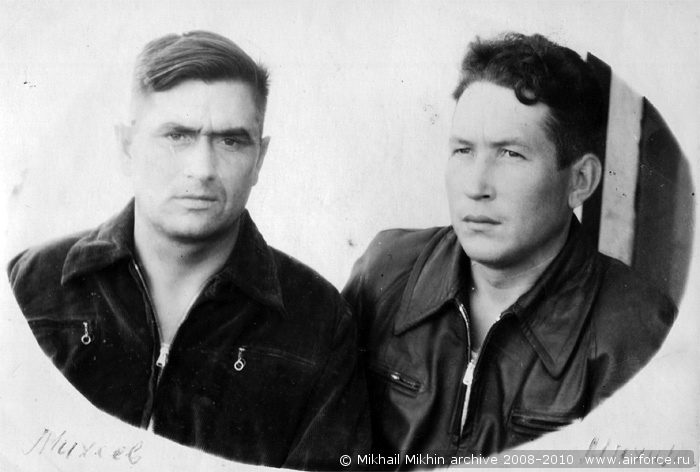
Semen Mikheev and Mikhail Mikhin.
— Did Americans strafe our pilots
descending on parachutes?
No. It was not ethical.
— But practical: «good enemy — dead
enemy!»
No, it was not noble. We fought without
any kind of pity to each other, but I can’t recall such events…
— I read that American rescue service
was very effective?
Yes. It was well organized. Their damaged
planes went to the open sea, and ejected there. Pilots were lifted from the
sea very soon.
— Did you have an order, forbidding
crossing the shore line?
We had an order. There were no
recommendations, only orders.
— Porfiriy Ovsyannikov told us that
they were recommended not to cross it, because there was no way save them
from the sea.
So that’s what was meant! Fine. No, we
were announced an order, there were no recommendations…
— It is written, that effective firing
range was somewhere in the area of 200 meters.
Correct.
— But fire could be opened at 1000
meters. Why?
Foolishness.
— And in your regiment which distance
was standard?
«Killing» distance was 200-300 meters. The
closer, the better.
Our gun sight allowed to fire at 1000-1200 meters. It was SPB semiautomatic
gun sight. Americans had radar assisted gun sight, and fired from even
further distances. Not that they actually hit…
— What about hitting power of their
machine guns?
They had six good machine guns - "Colt".
From close distance it hit like a saw! But our MiG fighter was very tough;
it was hard to bring down...
— Did you have MiG-17s there?
No. They were worse. MiG-17 was worse than
MiG-15 Bis.
— There are different opinions. Some
say that it was worse in maneuverability, but faster.
So many people, so many opinions.
— How would you describe or compare
your opponents in Korea?
Training in our units and American ones
was different. We came there by whole division, that is, there were
different pilots, experienced and newcomers. We learnt on our own
experience. Americans sent in volunteers. They were better trained, more
experienced. Some were there for two tours.
— That is, they were good pilots?
Nice pilots.
— Why then they had more losses than we
had?
We shot better. Besides, while we were on
strategic defense, we were tactically offensive.
— It is common question: MiG-15 or
Saber. Which you liked more?
By all means — our airplane. Planes were
different, pilots were different and maneuvers used in combat were
different. When we met Sabers in good dogfight, they escaped by diving. If
we needed to break away went into climb. And keep in mind, not a plane wins
battle, but pilot. Give all you want to a fool…
— Was there any difference between
Korea and GPW in psychological point of view?
I haven’t fought during GPW, so I can’t
compare… I was a professional military man. There was no need for psychology
for me… Enemy is enemy, either you kill him, or he will kill you. Simple
logic.
— You are a Hero of the Soviet Union?
It happens to be so.
— How many kills you scored?
Nine confirmed, but twelve in all. As we
used to say: “three went into the sea”.
— How kills were confirmed in Korea?
On the basis of confirmations. Why I have
nine kills? Because they were confirmed by Koreans: they crashed on Korean
territory and wrecks were located.
— What about gun camera? You should
have had one?
So what? A fact of hit? It did not confirm
shooting down. It does not make a photo of bits falling off. It shows first
rounds exploding or missing…
— All veterans say that gun camera only
shows hits, not downing of an airplane. Did you see them shot down?
Of course.
— How?
If it starts falling, it is shot down. If
it keeps flying, I missed.
— Did you see your targets falling to
the ground?
Not too often. There was no time to fixate
the impact — war was not going to wait. Or we could have been “fixated”
ourselves.
— Have you seen a plane falling like it
is shown in movies, black trail of smoke, fire, and parachutist?
No. I don’t want to lie. I haven’t seen
such things. It just goes down. Falling apart? To achieve such result you
have to hit it with cannon round.
— Well, you had one 37mm and two 23mm
cannons. It is written that a round of 37mm cannon caused holes meter by
meter.
So what? It did not fall apart. I hit
them, shot down. Breaking apart? I didn’t see them falling to pieces. Just
some small bits…
— Do you remember how you scored first
kill?
I don’t.
— What was your squadron composition?
Standard: 12 planes. But we fought in
eight plane formations. Always eight. Two flights. (Mikhin fought in
first squadron of 518 IAP, which began fighting in following composition:
1. Valentin Frolov, Major, Squadron commander;
2. Mikhail Mikhin, Sr. Lieutenant, Deputy squadron commander for flying;
3. Mikhail Ignatov, Kapitan, Deputy squadron commander for political
questions;
4. Vladimir Chernavin, Kapitan, flight commander;
5. Pavel Zagrebelny, Kapitan, flight commander;
6. Mikhail Bannov, Kapitan, flight commander;
7. Mikhail Abidin, Sr. Lieutenant, seniour pilot;
8. Leonid Pankov, Sr. Lieutenant, seniour pilot;
9. Boris Vadkovskii, Sr. Lieutenant, pilot;
10. Ivan Yakovlev, Sr. Lieutenant, pilot;
11. Vladimir Sedyshev, Sr. Lieutenant, pilot;
12. Mikhail Zotov, Sr. Lieutenant, pilot;
Two pilots from 1st squadron were killed in action: V. Chernavin
(14.09.1952) and V. Sedashev (14.03.1953). Squadron was reinforced by
Lieutenants Viktor Lapitskii and Boris Korshunov. Korshunov was killed in
action on 18.06.1953.
Four more pilots were shot down, but managed to escape (Yakovlev, Pankov,
Vadkovskii and Abidin. I.S.).
— Did you fight together with Chinese
pilots?
No. At my time they flew against ground
targets. They had no experience. All those who began fighting on
piston-engine fighters were killed. By the end of war they began flying
combat missions in jets.
— Who came as reinforcements?
Reinforcements were poor. Poorly trained.
It was usual practice: «Take God what we have no use of». We had to teach
them how to fight. Some came so weak, that they couldn’t fly at all. I don’t
know why, but reinforcements were weak.
— How you introduced them to battle?
Carefully. In the beginning we did not
allow them to fly most dangerous missions, trying to let them fly easy ones
instead. Introduction, airfields cover and so on.
— Did Americans bother you at Myaogou?
They did not bomb us, but visited often.
Hunter fighters. They shot down one of ours. And two navy pilots that came
from Vladivostok were shot down on takeoff. Our pilot was shot down on
landing.
— Which unit based at Myaogou?
Division? Regiment?
Two regiments (518th and 878th IAPs.
I.S.)
— Did you have equal amount of planes
and pilots?
There were more pilots then planes from
the beginning (In 216th IAD regiments there were more pilots then planes.
Reserve 8-10 pilots were used to reinforce squadrons if other pilots were
out of action for some reason – from wound, disease or death. I.S.).
— For which reasons pilots were sent
back to Soviet Union?
Everything happened. Because of wounds,
disease or cowardice. Everything happened. For “every letter of alphabet”.
— Where you lived?
We lived in the mountains; we were taken
there for night, at day time – at the airfield. We lived well. There were
aircraft transportation boxes, containers that were used for houses. Once we
were invited for a banquet to some palace.
— How you were fed?
Excellently. And differently.
— Was it Russian or Chinese cuisine?
Whatever you liked… Even trepangs. Do you
know what trepang is? Excellent food, very good food for men. It’s a pity
that I understood it only when we were about to leave.
— During GPW pilots received 100 grams
after combat missions.
We also received it. 100 grams. It was a
common thing in all armies around the world. In the evening 100 grams for
supper. That’s official, but you can bring more with you, if you like.
— Did it have a post-effect on the next
morning, when you had to fly combat missions again?
No. We did not drink till the loss of
conscience. Just a bit to relieve the stress. We knew our “norm”.
— Did you fly night missions?
Only day ones. We fought only at day time.
There was a special squadron of night fighters. They also flew MiGs. I
haven’t seen there a single piston-engine fighter.
— Let’s return to your victories. Do
you remember who you shot down?
Eight Sabers and one Thunderjet.
— Were you paid for kills?
Of course. If I remember correctly — 1 000
rubles for each plane shot down.
— And for combat missions separately?
Yes. For 25, 50, 100. I flew 140 missions.
— And you fought in?
Twenty-thirty… It would have been too
difficult – each mission with a fight. Not everyone could take it. And not
every fight ended with a kill.
— Did you have a vacation?
Yes. There was a resort near Port-Arthur.
— What you did there?
Played billiards, cards. At summer we
bathed… at winter went to sauna. Everything under medics’ control. Mostly
drinked.
— Were there cases of methyl alcohol
poisoning?
No. There was Chinese vodka, named
Zhemchug. But it was of Russian origin. Some famous Russian produced and
traded it.
— Did you speak with White Russian
immigrants there?
We had a translator, but who he was, I do
not know. I haven’t looked through his documents. And when I received 10 day
vacation, it was Russian who took me there.
— How you were picked for vacation?
Poor health condition? Amount of missions flown?
Don’t remember now.
— How was it with ranks there?
Not too bright. There are rules in the
army. For years of service.
— What about prescheduled promotion?
It is allowed only once during whole
career. When I came there and shot down 2-3 planes I was promoted to Kapitan
because time came. And that was it. However many planes I shot down. I was
still a Kapitan when I got a post of deputy regiment commander. I received a
major only in Soviet Union, three years later.
— How secret was your temporary duty
service?
We were just told not to talk about it,
and that was it.
— You flew many planes. What is your
favorite airplane?
MiG-15 Bis.
— What about later MiGs?
I was transferred to Yaks then. Yak-25,
some other Yak… 28, maybe. It had bicycle landing gear and supports on
wingtips. Heavy, very heavy. Uncomfortable to fly, it had a crew of 2. But
25 also had a 2 men crew.
— What about comfort in the cockpit?
Equipment? Instrument disposition? MiG was also better then Yak?
What a spoilt man you are, you want
comfort... When time comes, you have to fight in any conditions. Don’t think
about comfort. I see a man thinking of pleasure at war for the first time.
For me each day at war was unpleasant.
— Were you ever hit?
No, I wasn’t.
— Did you jump with parachutes?
It training purposes I made 25 jumps.
Pilot has to make 2 training jumps per year.
— Let’s return to the planes. Which
tactical numbers you had? Two, three digit?
I had four digit numbers. I received it
from previous pilot. Someone flew it… But mostly numbers were two digits. So
I was like a “white crow”, the only one with long number. It was in first
squadron for some time, and then I received it, and didn’t repaint it or
made any adjustments.
— Did you have silvery planes or
painted ones?
Silvery. It was decided to paint them
later. It was not green… Grayish…
— When it was first applied?
Somewhere in the middle, in 1953, most
likely (Summer-Autumn 1952. I.S.)
— Did you paint noses in red?
No.
— What color was tactical number
painted in?
Red.
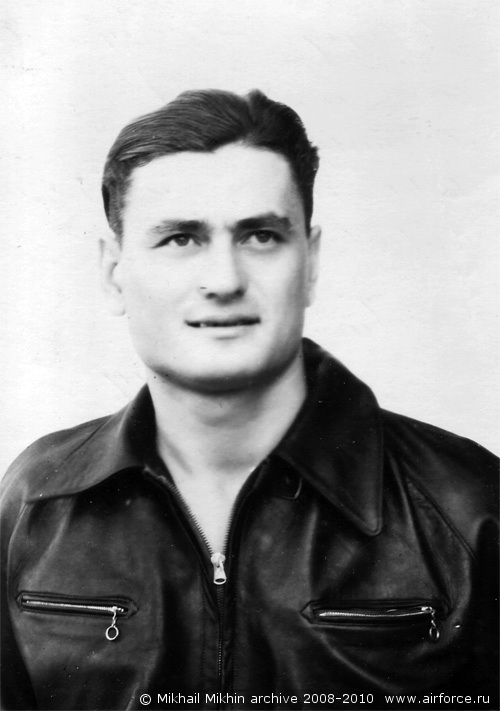
Mikhail Ignatov
— Did you fly on one and the same plane
till the end of war?
Till the end. On one and the same plane.
— What if it was in for repairs?
Then I flew some other one. But it was a
rare occasion.
— Did you fly test missions to
establish Valezhka speed?
There were no special missions flown, but
if Americans put us into difficult situation, we could reach Valezhka. Our
maximum speed was 1 100 km\h, beyond it plane could break apart. When plane
begun respond poorly at controls we simply reduced speed a bit.
— How you fought against G-load?
How… hold on as long as you can, if you
can’t hold on, you shouldn’t have come in the first place…
— Did you know that Americans had
G-suits and what was your attitude towards it?
Yes, we knew. Attitude was good, I mean,
bad… We didn’t have them, but wanted to have.
— Were there political officers in your
regiment? What did they do?
Yes, there were. Their business was
talking. A pilot was appointed as political officer, and he talked about
different things.
— We talked to many veterans, and most
of them speak in negative tones about political officers.
It heavily depended on person. I knew one
political officer who received 4 “combat banners” during GPW. Pilot. He
later became a chief of political department in our division.
— Were there special service
representatives in your regiment?
Of course. In every regiment.
— Did they cause any trouble to you?
You wouldn’t know real special service
agent. If he is spotted, he is not effective. If he causes trouble, such
agent is removed.
— Were there cases of friendly fire?
Friendly fire? It is possible. Most likely
they were. But I don’t know a single case if someone was downed by friendly
fire…
— How many missions pilot had to fly to
become fully combat ready?
It depended on pilots abilities. Usually
it took about 10 missions to be able to fight. But if he is a coward you
will not make him combat ready however many missions he flew, even if 100.
— How you dealt with such pilots?
They were sent to Soviet Union and fast…
— Did Koreans bring you captured
Americans?
I saw one through special glass. I saw
him, while he did not see me. He was interrogated, and I asked to take a
look. Special service agent interrogated him. This American was on his
second tour. That’s why I decided to go and take a look at him.
— Do you remember his name?
No. But he was a First Lieutenant.
— When approximately it happened?
Damn me if I know. In the beginning of
1953, I think.
— Did he tell anything interesting?
Interrogation was made in English. Without
translation. But I never knew English language.
— Was he interrogated by our
specialists or Chinese?
Our.
— In your opinion, what was main
deficiency of American pilots?
Each man is a personality. He has a lot of
weak and strong points. But in general — too much arrogance. But when they
received two-three kicking’s in a row, they would disappear for about a
month. Then they would start again. We would chase them again, and they
would disappear again…
— What were the heaviest losses that
Americans caused to your regiment?
We lost four pilots. (Five pilots were
lost by the regiment: V. Chernavin, V. Sedyshev, B. Korshunov, F.
Yeremchenko (2nd squadron) and K. Rybakov(3rd squadron) I.S.).
— In one day?
Not in one day, but for all time there!
Total plane loss count was around 15-20 planes, including lost in accidents
(In all 518th IAP lost in Korea 15 airplanes and 5 pilots. Largest
onetime loss: 3 planes downed on 4.09.1952 – all pilots safely ejected. I.S.).
— And how many losses you inflicted to
Americans? How many planes you shot down in one fight?
One, two. No more. (518th IAP pilot
really claimed no more then 1-2 planes shot down. Most successful day was
09.09.52, when Mikhin had 1 F-86 as confirmed kill and another as shot up,
while Sr. Lieutenant Ye. Stadnik shot down one more F-86. Unluckily, it is
impossible to say whether it happened in one fight or not – data came from
summary for a day. In all 518 IAP pilots claimed to shoot down 38 UN
aircraft (36 F-86, 1 F-84 and 1 Gloster Meteor), and damaged 26 more enemy
planes (all F-86) I.S.).
— Was there enough ammo?
Enough. If pilot was smart, he would even
leave some for return flight, not to be caught with empty bores on landing.
I told you already that there were American hunters prowling near our
airfield.
— Did you try to hunt the hunters?
I did, most of my last missions were “free
hunt”.
— Did you manage to catch any of them?
Not a single time. They were smart guys
too. What kind of a hunter are you if you can be hunted at? It is not a
hunter, but “game”.
Well, enough for now, I have to rest, let’s meet some time later…
Next meeting did not take place – on
25.03.2007 Mikhail Ivanovich Mikhin passed away...
M.I. Mikhin flew 140
combat missions in Korea, participated in 67 fights, shot down 9 and shot
up3 enemy planes.
Score list:
09.08.1952 – Shot up F-86
19.08.1952 – Shot down F-86
04.09.1952 – Shot down F-86(F-86E №51-2722 from 335FIS 4 FIW, pilot Ira. M.
Porter ejected and picked up by rescue team)
06.09.1952 – Shot down F-86
08.09.1952 – Shot down F-84(F-84E-25 №51-596 from 9 FBS 49 FBW, pilot Bruce
R. Campbell stayed alive)
09.09.1952 – Shot down F-86(supposedly F-86E №50-0672 from 4 FIW, pilots
fate unknown)
09.09.1952 – Shot up F-86 (supposedly F-86E №50-0666 from 334FIS 4 FIW,
pilot Dunlap crashed his plane on landing)
12.09.1952 – Shot down F-86
18.09.1952 – Shot down F-86(Supposedly F-84G-15 №51-1157 from 430 FBS 474
FBW, its pilot Calvin E. Hodel went MIA)
29.09.1952 – Shot down F-86
29.09.1952 – Shot up F-86
18.05.1953 – Shot down F-86
I.S.